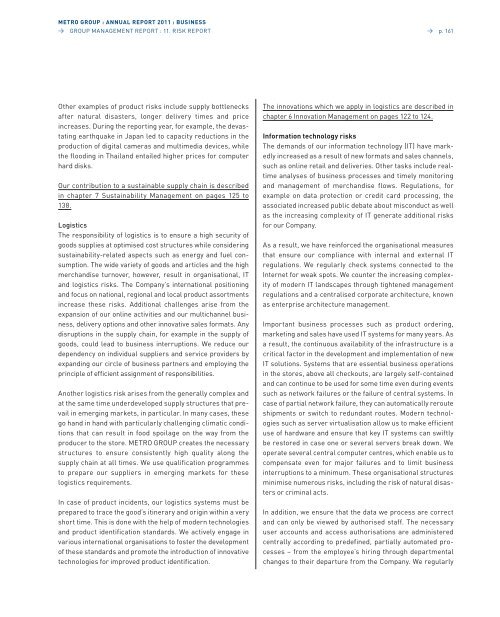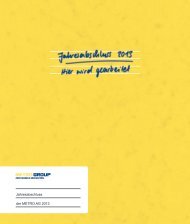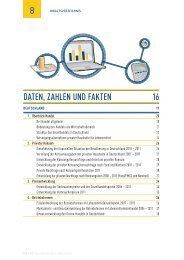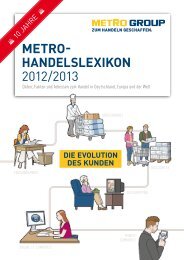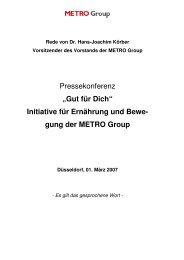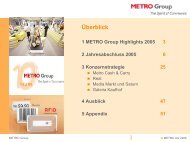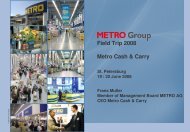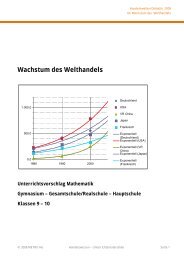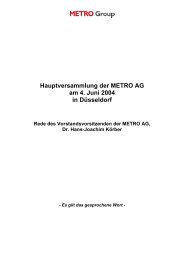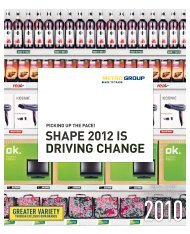pdf (22.8 MB) - METRO Group
pdf (22.8 MB) - METRO Group
pdf (22.8 MB) - METRO Group
You also want an ePaper? Increase the reach of your titles
YUMPU automatically turns print PDFs into web optimized ePapers that Google loves.
<strong>METRO</strong> GROUP : ANNUAL REPORT 2011 : BUSINESS<br />
→ GROUP MANAGEMENT REPORT : 11. Risk REPORT<br />
other examples of product risks include supply bottlenecks<br />
after natural disasters, longer delivery times and price<br />
increases. During the reporting year, for example, the devastating<br />
earthquake in Japan led to capacity reductions in the<br />
production of digital cameras and multimedia devices, while<br />
the flooding in Thailand entailed higher prices for computer<br />
hard disks.<br />
our contribution to a sustainable supply chain is described<br />
in chapter 7 sustainability Management on pages 125 to<br />
138.<br />
Logistics<br />
The responsibility of logistics is to ensure a high security of<br />
goods supplies at optimised cost structures while considering<br />
sustainability-related aspects such as energy and fuel consumption.<br />
The wide variety of goods and articles and the high<br />
merchandise turnover, however, result in organisational, IT<br />
and logistics risks. The Company’s international positioning<br />
and focus on national, regional and local product assortments<br />
increase these risks. additional challenges arise from the<br />
expansion of our online activities and our multichannel business,<br />
delivery options and other innovative sales formats. any<br />
disruptions in the supply chain, for example in the supply of<br />
goods, could lead to business interruptions. We reduce our<br />
dependency on individual suppliers and service providers by<br />
expanding our circle of business partners and employing the<br />
principle of efficient assignment of responsibilities.<br />
another logistics risk arises from the generally complex and<br />
at the same time underdeveloped supply structures that prevail<br />
in emerging markets, in particular. In many cases, these<br />
go hand in hand with particularly challenging climatic conditions<br />
that can result in food spoilage on the way from the<br />
producer to the store. MeTRo GRoUp creates the necessary<br />
structures to ensure consistently high quality along the<br />
supply chain at all times. We use qualification programmes<br />
to prepare our suppliers in emerging markets for these<br />
logistics requirements.<br />
In case of product incidents, our logistics systems must be<br />
prepared to trace the good’s itinerary and origin within a very<br />
short time. This is done with the help of modern technologies<br />
and product identification standards. We actively engage in<br />
various international organisations to foster the development<br />
of these standards and promote the introduction of innovative<br />
technologies for improved product identification.<br />
→ p. 161<br />
The innovations which we apply in logistics are described in<br />
chapter 6 Innovation Management on pages 122 to 124.<br />
information technology risks<br />
The demands of our information technology (IT) have markedly<br />
increased as a result of new formats and sales channels,<br />
such as online retail and deliveries. other tasks include realtime<br />
analyses of business processes and timely monitoring<br />
and management of merchandise flows. Regulations, for<br />
example on data protection or credit card processing, the<br />
associated increased public debate about misconduct as well<br />
as the increasing complexity of IT generate additional risks<br />
for our Company.<br />
as a result, we have reinforced the organisational measures<br />
that ensure our compliance with internal and external IT<br />
regulations. We regularly check systems connected to the<br />
Internet for weak spots. We counter the increasing complexity<br />
of modern IT landscapes through tightened management<br />
regulations and a centralised corporate architecture, known<br />
as enterprise architecture management.<br />
Important business processes such as product ordering,<br />
marketing and sales have used IT systems for many years. as<br />
a result, the continuous availability of the infrastructure is a<br />
critical factor in the development and implementation of new<br />
IT solutions. systems that are essential business operations<br />
in the stores, above all checkouts, are largely self-contained<br />
and can continue to be used for some time even during events<br />
such as network failures or the failure of central systems. In<br />
case of partial network failure, they can automatically reroute<br />
shipments or switch to redundant routes. Modern technologies<br />
such as server virtualisation allow us to make efficient<br />
use of hardware and ensure that key IT systems can swiftly<br />
be restored in case one or several servers break down. We<br />
operate several central computer centres, which enable us to<br />
compensate even for major failures and to limit business<br />
interruptions to a minimum. These organisational structures<br />
minimise numerous risks, including the risk of natural disasters<br />
or criminal acts.<br />
In addition, we ensure that the data we process are correct<br />
and can only be viewed by authorised staff. The necessary<br />
user accounts and access authorisations are administered<br />
centrally according to predefined, partially automated processes<br />
– from the employee’s hiring through departmental<br />
changes to their departure from the Company. We regularly


